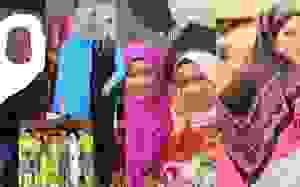Historical Truths About The Pendatang

HISTORY: TOLD AS IT IS | Over the last two decades, there have been several instances of non-Malay Malaysian citizens being derogatorily referred to as “pendatang” by a few Malays, particularly politicians as well as influential individuals.
Those who engage in such acts appear to be bent on reasserting the notion of Malay dominance or “ketuanan Melayu” as part of their brand of ethno-nationalism. To make matters worse, they blatantly asked non-Malay citizens to return to China or India if they are unhappy with the state of affairs in Malaysia.
For example, in 2008, Ahmad Ismail – then Bukit Bendera Umno chief in Penang – was suspended from Umno for three years following an uproar over his remarks allegedly describing Chinese Malaysians as “pendatang” or immigrants during a political rally in Permatang Pauh. His suspension was subsequently lifted in December 2009 by the Umno Supreme Council.
Furthermore, in 2010, the head of a school in Kulai, Johor had labelled non-Malay pupils “pendatang” whilst a school headmistress in Shah Alam in 2013 told non-Malay pupils to “go back to India and China” for allegedly being unruly during an assembly.
This article seeks to explore the historical truths about the term “pendatang” by seeking the answers to several questions: What is the true meaning of “pendatang”? Is it correct and fair to refer to Malaysian citizens of Chinese and Indian origins as “pendatang”? While the Malays are acknowledged as among the earlier settlers in Peninsular Malaysia, was there also a significant proportion of them who arrived much later to join and make up the community?
Let’s begin by clarifying the term “pendatang”. As defined in Kamus Dewan (fourth edition), the term “pendatang” refers to foreigners who come to or enter another country. Presumably, it is in this context that non-Malay citizens in Malaysia are referred to as “pendatang” or immigrants since their forebears had immigrated in large numbers beginning from the second half of the 19th century to Peninsular Malaysia.
Incidentally, and as mentioned in an earlier article of mine, during the early decades of the 19th century, Peninsular Malaysia was inhabited almost entirely by the aborigines (Orang Asli) in the hilly and forested areas while the Malays in greater numbers had established kingdoms in the riverine valleys and coastal areas.
Long-standing settlers
Most accounts of the emergence of a plural society in Peninsular Malaysia ignore the fact that the Indians and Chinese were, in the words of Virginia Matheson Hooker, “settlers of long-standing in the region”. This is mostly due to the popular notion that the vast number of the forebears of current Indians and Chinese Malaysians immigrated to Peninsular Malaysia beginning from the second half of the 19th century.
As stated by Roland Braddel, there were Indian settlements in Peninsular Malaysia from the first century CE. Some of the Indians married into leading local families. During the 15th century, Tamil Muslims married into the families of the rulers and bendaharas of the Malacca sultanate.
For example, Sultan Muhammad Syah (Sri Maharaja) of Malacca married a Tamil who bore him Sultan Muzaffar Syah, the fifth ruler (c.1446-1459). Further, the Chetties or “Peranakan Indians” are the descendants of early South Indian Hindu traders who had married local women and settled down from the time of the Malacca sultanate.
It is not generally known that Indian labour immigration into Peninsular Malaysia had commenced by 1787. By the early 1790s, there were about 1,000 Indian shopkeepers and coolies in Penang. Subsequently, in 1858, the number of Indians in Penang increased to about 12,000.
In the case of the Chinese, their earliest settlements in Peninsular Malaysia were formed after the foundation of the Malay sultanate of Malacca. The Baba community or “Peranakan Chinese” are the descendants of Chinese traders who had settled down in Malacca after marrying local women as early as the 15th century. The Chinese population in Malacca had increased to 2,161 by 1750. They later migrated to Penang and Singapore after the formation of the Straits Settlements in 1826. In Penang, the number of Chinese increased from about 3,000 in 1794 to 7,291 in 1812.
Interestingly, in the early decades of the 18th century, there were hundreds of Chinese residing in Kuala Terengganu. They were mainly engaged in trade, pepper cultivation and gold mining. There were also Chinese settlements in Kelantan in the 18th century, with most of the Chinese being traders in Kuala Kelantan and gold miners in the interior. Many Chinese women in Kelantan married Malays. Another noteworthy fact is that in the early 19th century, there were about 12,000 Chinese in Pahang who were primarily engaged in agriculture and mining.
It should also be noted that in 1931, 29.9 percent of the Chinese and 21.4 percent of the Indians were locally born. These percentages increased respectively to 63.5 percent and 51.6 percent in 1947.
‘People of the land’
While Indians and Chinese presence in Peninsular Malaysia actually can be traced to a much longer period, it is also a fact that among the Malays too there have been some proportion of migrants in the 20th century. Writing about the Malays in the 1930s, Rupert Emerson observed that “a very considerable proportion of the present Malay population is made up of immigrants who were themselves born elsewhere or whose forebears came to Malaya only in the last few decades.”
Indeed, according to the 1931 Census Report, “only a negligible fraction of the Malay population consists of descendants of pre-19th century immigrants and that more than half of it has less than 50 years’ prescriptive right to the title ‘owners of the soil’. The Malays are, in fact, merely immigrants of generally longer standing than the other migrant races represented in the peninsula …”
Furthermore, according to the 1947 Census Report, about 26 percent of the Malays in Peninsular Malaysia were immigrants from Sumatra, Jawa and other islands of what is currently Indonesia. The census also reveals that the Malay population in Selangor increased from 26,000 in 1891 to about 185,000 in 1947 mainly as a result of extensive immigration. Similarly in Johor, the recent immigrants from Indonesia formed 35 percent of the Malay population.
At the same time, it is an indisputable fact that the Malays constituted 85.9 percent of the population in 1835. The Chinese formed only 7.7 percent of the population and the Indians less than 1 percent. For the record, the British colonial administrators regarded the Malays as the indigenous people of Peninsular Malaysia or “people of the land”, and signed treaties with Malay sultans.
Ultimately, as rightly reiterated by the late Emeritus Professor Dr Khoo Kay Kim, we are all citizens of Malaysia and none of us should be labelled as “immigrants” or “pendatang”. Anyone who has Malaysian citizenship cannot be deemed to be a “pendatang”; a “pendatang” cannot be a citizen. The use of the label “pendatang” on any citizen of this nation is historically incorrect, insensitive, racist and divisive.
Furthermore, one must not forget the important roles and significant contributions of the Chinese and Indians in transforming Peninsular Malaysia from jungle and swamp into one of the best developed countries in Southeast Asia.
As noted by Kernial Singh Sandhu, a renowned academician, Chinese and Indian capital, enterprise and labour contributed significantly towards the creation of modern Peninsular Malaysia. According to Charles Vlieland, who compiled the 1931 Census Report, the “phenomenal development” of Peninsular Malaysia during the early decades of the 20th century has been due largely to the “industry, enterprise, and commercial genius” of the Chinese.
It is also worth mentioning that the Malays are not the earliest inhabitants of Peninsular Malaysia. The earliest inhabitants or original people of Peninsular Malaysia are the Orang Asli – more specifically, the Negritos who probably descended from the toolmakers of the Mesolithic cultural period beginning from about 10,000 years ago.
As stated by Richard Wilkinson and Rupert Emerson, two renowned historians, the Malays who arrived later supplanted the Orang Asli and kept to the river valleys and coastal areas, driving the Orang Asli, who feared being captured as slaves, to the hills and forests. Similarly, Charles Vlieland states that a large proportion of Malays trace their ancestry to Sumatra.
To conclude, it is incorrect to refer to any Malaysian citizen as “pendatang”. “Pendatang” refers to foreign nationals who come to or enter Malaysia, and is not applicable to full-fledged bona fide citizens of Malaysia.
The non-Malays, except for the usual chauvinistic few among them, do not question in general the notion that the Malays are the “sons of the soil”. In a similar spirit, proponents of the bigoted and misguided ideology of Malay dominance and ethno-nationalism should realise that labelling the non-Malays, who are citizens and proudly consider Malaysia as their home, as “pendatang” is unfair and a gross distortion of historical truth. - Mkini
RANJIT SINGH MALHI is an independent historian who has written 19 books on Malaysian, Asian and world history. He is highly committed to writing an inclusive and truthful history of Malaysia based upon authoritative sources.
The views expressed here are those of the author/contributor and do not necessarily represent the views of MMKtT.
Artikel ini hanyalah simpanan cache dari url asal penulis yang berkebarangkalian sudah terlalu lama atau sudah dibuang :
http://malaysiansmustknowthetruth.blogspot.com/2021/11/historical-truths-about-pendatang.html
 PING BABAB : Raksasa Aggregator Malaysia
PING BABAB : Raksasa Aggregator Malaysia




























